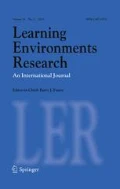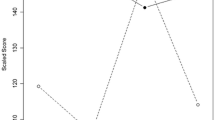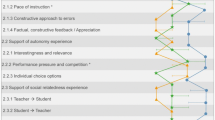Abstract
In this article, we examine the construct and criteria validity of student and teacher ratings as indicators of instructional features. As parsimonious measures, student and teacher reports are frequently used to assess aspects of the learning environment. From a methodological perspective, however, both approaches have been questioned. Whereas student ratings are occasionally criticised as being undifferentiated and easily influenced by personal preferences, teacher reports are sometimes considered to be biased by self-serving strategies or teaching ideals. Instead of pitting one method against the other, our study aimed at establishing the specific value of each approach. The analyses draw on data from a German extension to the 2003 PISA assessment, in which 288 mathematics teachers and their students completed questionnaires using identical items to tap various aspects of instruction. Mean student ratings were computed for each class. Exploratory and confirmatory factor analyses revealed specific conceptual structures for student and teacher ratings, with teachers elaborating on the use of tasks and methods, and students focusing on their teacher’s support in personal and learning matters. Three shared dimensions were also established: occurrence of classroom management problems, degree of cognitive autonomy during lessons, and tempo of interaction. Teacher/student agreement on these dimensions varied across constructs, with considerable agreement on classroom management, low agreement on cognitive autonomy, and no significant agreement on whether or not the interaction tempo was appropriate. Accordingly, correlations with external criteria (student motivation, teacher motivation, mathematical achievement scores, and characteristics of the tasks set in class) also varied across constructs. We conclude that student and teacher ratings are best suited to tapping different aspects of the learning environment, and recommend that care be taken in choosing a data source appropriate for the construct to be measured.
Similar content being viewed by others
Notes
Note that we did not test for higher-order factors; our categorisation to underlying dimensions is purely theoretical.
Further analyses showed that the model fit would be improved by introducing a nested-factor model in which a general student factor (reflecting a general response tendency, regardless of the specific construct) was specified in addition to the eight teacher and five student factors (χ 2 = 2,366.914, df = 1,381, p < 0.05; RMSEA = 0.050; SRMR = 0.081; CFI = 0.915). No support was found for a model featuring a corresponding teacher factor. Judging from the fit statistics, this model was not a significant improvement on the model with a student method factor only. In addition, only half of the factor loadings for the teacher items on the teacher method factor showed statistical significance, making the applicability of a general method factor unlikely.
References
Aleamoni, L. M. (1999). Student rating myths versus research facts from 1924 to 1998. Journal of Personnel Evaluation in Education, 13(2), 153–166.
Baumert, J., Kunter, M., Brunner, M., Krauss, S., Blum, W., & Neubrand, M. (2004). Mathematikunterricht aus Sicht der PISA-Schülerinnen und -Schüler und ihrer Lehrkräfte [Mathematics teaching from the perspective of the PISA students and their teachers]. In The German PISA Consortium (Ed.), PISA 2003: Der Bildungsstand der Jugendlichen in Deutschland—Ergebnisse des zweiten internationalen Vergleichs [PISA 2003: The educational level of adolescents in Germany—the second international comparison] (pp. 314–354). Münster, Germany: Waxmann.
Ben-Chaim, D., & Zoller, U. (2001). Self-perception versus students’ perception of teachers’ personal style in college science and mathematics courses. Research in Science Education, 31(3), 437–454.
Brophy, J. (1999). Teaching. Geneva, Switzerland: International Academy of Education/International Bureau of Education.
Clausen, M. (2002). Unterrichtsqualität: Eine Frage der Perspektive? [Instructional quality: A question of perspectives?] Münster, Germany: Waxmann.
de Corte, E., Greer, B., & Verschaffel, L. (1996). Mathematics teaching and learning. In D. C. Berliner & R. C. Calfee (Eds.), Handbook of educational psychology (pp. 491–549). New York: Simon & Schuster Macmillan.
De Jong, R., & Westerhof, K. J. (2001). The quality of student ratings of teacher behaviour. Learning Environments Research, 4(1), 51–85.
den Brok, P., Bergen, T., & Brekelmans, M. (2003, April). Comparing student’ and teachers’ perceptions of instructional behavior in Dutch secondary education. Paper presented at the annual meeting of the American Educational Research Association, Chicago.
den Brok, P., Bergen, T., & Brekelmans, M. (2006). Convergence and divergence between students’ and teachers’ perceptions of instructional behaviour in Dutch secondary education. In D. L. Fisher & M. S. Khine (Eds.), Contemporary approaches to research on learning environments: World views (pp. 125–160). Singapore: World Scientific.
Floden, R. E. (2002). The measurement of opportunity to learn. In A. C. Porter, A. Gamoran, & National Research Council/Board on International Comparative Studies in Education (Eds.), Methodological advances in cross-national surveys of educational achievement (pp. 231–266). Washington, DC: National Academy Press.
Fraser, B. (1991). Two decades of classroom environment research. In H. J. Walberg (Eds.), Educational environments: Evaluation, antecedents and consequences (pp. 3–27). Elmsford, NY: Pergamon.
Gentry, M., Gable, R. K., & Rizza, M. G. (2002). Students’ perceptions of classroom activities: Are there grade-level and gender differences? Journal of Educational Psychology, 94(3), 539–544.
Greenwald, A. G. (1997). Validity concerns and usefulness of student ratings of instruction. American Psychologist, 52(11), 1182–1186.
Jordan, A., Ross, N., Krauss, S., Neubrand, M., Baumert, J., Brunner, M. et al. (Eds.). (2006). Klassifikationsschema für Mathematikaufgaben: Dokumentation der Aufgabenkategorisierung im COACTIV-Projekt [Classification Scheme for Mathematical Problems: A documentation of the coding system for mathematics tasks in the COACTIV project]. Berlin, Germany: Max Planck Institute for Human Development.
Klieme, E., Schümer, G., & Knoll, S. (2001). Mathematikunterricht in der Sekundarstufe I: “Aufgabenkultur” und Unterrichtsgestaltung [Mathematical instruction in secondary school: “Task culture” and instructional settings]. In Federal Ministry of Education and Research (Ed.), TIMSS—Impulse für Schule und Unterricht [TIMSS—Impulses for school and classroom instruction] (pp. 43–57). Bonn, Germany: Federal Ministry of Education and Research.
Krauss, S., Kunter, M., Brunner, M., Baumert, J., Blum, W., Neubrand, M. et al. (2004). COACTIV: Professionswissen von Lehrkräften, kognitiv aktivierender Mathematikunterricht und die Entwicklung von mathematischer Kompetenz [Professional knowledge of teachers, cognitively activating mathematics instruction and the development of mathematical literacy]. In J. Doll & M. Prenzel (Eds.), Bildungsqualität von Schule: Lehrerprofessionalisierung, Unterrichtsentwicklung und Schülerforderung als Strategien der Qualitätsverbesserung [School quality: Improving quality through teacher education, instruction, and student support] (pp. 31–53). Münster, Germany: Waxmann.
Kunter, M., & Baumert, J. (2006). Linking TIMSS to research on learning and instruction: A re-analysis of the German TIMSS and TIMSS video data. In S. J. Howie & T. Plomp (Eds.), Learning mathematics and science: Lessons learned from TIMSS (pp. 335–351). London: Routledge.
Kunter, M., Brunner, M., Baumert, J., Klusmann, U., Krauss, S., Blum, W., Jordan, A., & Neubrand, M. (2005). Der Mathematikunterricht der PISA-Schülerinnen und-Schüler: Schulformunterschiede in der Unterrichtsqualität [Quality of mathematics instruction across school types: Findings from PISA 2003]. Zeitschrift für Erziehungswissenschaft, 8(4), 502–520.
Lanahan, L., McGrath, D. J., McLaughlin, M., Burian-Fitzgerald, M., & Salganik, L. (2005). Fundamental problems in the measurement of instructional processes: Estimating reasonable effect sizes and conceptualizing what is important to measure. Washington, DC: American Institutes for Research.
Marsh, H. W., Trautwein, U., Lüdtke, O., Köller, O., & Baumert, J. (2005). Academic self-concept, interest, grades and standardized test scores: Reciprocal effects models of causal ordering. Child Development, 76(2), 397–416.
Mayer, D. P. (1999). Measuring instructional practice: Can policy makers trust survey data? Educational Evaluation and Policy Analysis, 21(1), 29–45.
Mayer, R. E. (2004). Teaching of subject matter. Annual Review of Psychology, 55, 715–744.
Muthén, L. K., & Muthén, B. O. (1998–2004). Mplus user’s guide (3rd ed.). Los Angeles: Muthén & Muthén.
Porter, A. C. (2002). Measuring the content of instruction: Uses in research and practice. Educational Researcher, 31(7), 3–14.
The German PISA Consortium (Ed.). (2004). PISA 2003. Der Bildungsstand der Jugendlichen in Deutschland—Ergebnisse des zweiten internationalen Vergleichs [PISA 2003: Literacy of Adolescents in Germany]. Münster, Germany: Waxmann.
Urdan, T. (2003, August). Using multiple methods to assess students’ perceptions of classroom goal structures. Paper presented at the 10th Conference of the European Association for Research in Learning and Instruction (EARLI), Padua, Italy.
Weinert, F. E., Schrader, F.-W., & Helmke, A. (1989). Quality of instruction and achievement outcomes. International Journal of Educational Research, 13(8), 895–914.
Wubbels, T., Brekelmans, M., & Hooymayers, H. P. (1992). Do teacher ideals distort the self-reports of their interpersonal behavior? Teaching and Teacher Education, 8(1), 47–58.
Acknowledgements
The research reported is based on data from the COACTIV study (COACTIV: Professional Competence of Teachers, Cognitively Activating Instruction, and the Development of Students’ Mathematical Literacy) directed by Jürgen Baumert (Max Planck Institute for Human Development, Berlin), Werner Blum (Kassel University) and Michael Neubrand (Carl von Ossietzky University, Oldenburg). The project is funded by the German Research Foundation (DFG; BA 1461/2-2) as part of its priority program on School Quality (BIQUA). We thank our co-researchers Martin Brunner, Uta Klusmann, Stefan Krauss, Katrin Löwen and Yi-Miau Tsai for their support in the COACTIV project. We also thank Oliver Lüdtke for his advice and Susannah Goss for her language editing on this article.
Author information
Authors and Affiliations
Corresponding author
Appendices
Appendix 1
Student questionnaire items with loadings on the latent factors and interfactor correlations
Questionnaire item | Factor loadings | ||||
|---|---|---|---|---|---|
Inefficient classroom management | Inadequate interaction tempo | Tasks | Experience of cognitive autonomy | Perceived social support from the teacher | |
In mathematics the lesson often starts late. | 0.79 | ||||
... it takes a very long time at the start of the lesson until the students have settled down and started working. | 0.95 | ||||
... a lot of lesson time is wasted. | 0.93 | ||||
... students mess around the whole time. | 0.95 | ||||
... students talk among themselves the whole time. | 0.96 | ||||
... teaching is very often interrupted. | 0.95 | ||||
... teacher often expects split-second answers. | 0.77 | ||||
Our mathematics teacher does not leave us much time to think when asking questions. | 0.99 | ||||
... often sets problems where it is not just the calculation that is important, but choosing the right approach. | 0.71 | ||||
... sets problems where we have to take time to think. | 0.56 | ||||
... sometimes asks us to demonstrate several different ways of solving a problem. | 0.57 | ||||
... sometimes sets problems that do not have a clear-cut solution and asks us for explanations. | 0.57 | ||||
... changes the setting of problems to find out whether we have really understood the mathematical idea. | 0.75 | ||||
... varies problems to find out what we have understood. | 0.83 | ||||
... lets us use our own strategies to solve difficult problems. | 0.76 | ||||
... lets us solve problems according to our personal preferences. | 0.64 | ||||
In mathematics lessons our teacher sometimes lets us go astray in our working until we notice that something is wrong. | 0.59 | ||||
In mathematics lessons our teacher sometimes accepts mistakes and lets us carry on until we see that something must be wrong. | 0.63 | ||||
Our mathematics teacher immediately knows what someone has not understood. | 0.91 | ||||
... immediately notices if someone has not understood something properly. | 0.92 | ||||
... knows exactly what each of us can accomplish. | 0.74 | ||||
... always notices immediately if a student is not keeping up. | 0.92 | ||||
... is quick to see if students have argued. | 0.83 | ||||
... is quick to see if there’s something wrong between students sitting next to each other. | 0.82 | ||||
... soon notices if a student has problems or worries. | 0.84 | ||||
... can easily tell if someone is really sad. | 0.82 | ||||
... always addresses students’ problems. | 0.93 | ||||
... always takes time to talk if students want to discuss something with him/her. | 0.84 | ||||
Factor | Interfactor correlations | ||||
Inefficient classroom management | 1.00 | ||||
Inadequate interaction tempo | 0.29* | 1.00 | |||
Tasks | −0.41* | −0.27* | 1.00 | ||
Experience of cognitive autonomy | −0.23* | −0.35* | 0.57* | 1.00 | |
Personal support | −0.23* | −0.57* | 0.41* | 0.74* | 1.00 |
Appendix 2
Teacher questionnaire items with loadings on the latent factors and interfactor correlations
Questionnaire item | Factor loadings | |||||||
|---|---|---|---|---|---|---|---|---|
Inefficient classroom management | Inadequate interaction tempo | Cognitive challenging tasks | Variation of tasks | Supporting cognitive autonomy | Use of student errors | Monitoring problems | Providing social support | |
It is difficult to start the lesson on time in this class. | 0.83 | |||||||
In this class, it takes a long time at the beginning of the mathematics lesson until the students are quiet and begin working. | 0.82 | |||||||
I often have the impression that a lot of time is wasted in mathematics lessons in this class. | 0.69 | |||||||
The students in this class mess around a lot. | 0.82 | |||||||
The students in this class talk among themselves a lot. | 0.80 | |||||||
Lessons are very often disrupted in this class. | 0.85 | |||||||
I expect quick answers to spontaneous questions in this class. | 0.42 | |||||||
If a student cannot answer a question, I move on to the next student immediately. | 1.00 | |||||||
I set problems where it is not just computation that is important, but choosing the right approach. | 0.45 | |||||||
I set problems where students have to take time to think. | 0.65 | |||||||
I sometimes ask students to demonstrate several different ways of solving a problem. | 0.59 | |||||||
I set problems that do not have a clear-cut solution and ask students for explanations. | 0.62 | |||||||
I change the setting of problems so that I can see whether the student has really understood the mathematical idea. | 0.67 | |||||||
I vary problems so that I can see what the students have understood. | 0.77 | |||||||
I let students apply their own strategies to solve math problems. | 0.54 | |||||||
I let students solve mathematics problems according to their personal preferences. | 1.00 | |||||||
I sometimes deliberately let the students go astray until they realise that something must be wrong. | 0.86 | |||||||
If a student makes a mistake when a new topic is being covered, I initially accept the suggestion without comment, and carry on working through the problem with the students until the mistake becomes obvious. | 0.57 | |||||||
It is easy for me to tell whether a student has understood a problem. | 0.57 | |||||||
I am very quick to notice if someone has not understood something. | 0.60 | |||||||
I know the strengths and weaknesses of individual students. | 0.54 | |||||||
I immediately notice if a student is not keeping up. | 0.56 | |||||||
I am quick to see if students have argued. | 0.69 | |||||||
I am quick to see if there’s something wrong between students sitting next to each other. | 0.70 | |||||||
I am quite quick to notice if a student has problems or worries. | 0.79 | |||||||
I can easily tell if someone is really sad. | 0.72 | |||||||
I take care of my students if they have problems. | 0.76 | |||||||
I take time to listen if my students want to discuss something with me. | 0.82 | |||||||
Factor | Interfactor correlations | |||||||
Inefficient classroom management | 1.00 | |||||||
Inadequate interaction tempo | 0.10 | 1.00 | ||||||
Cog. Challenging tasks | −0.24* | −0.27* | 1.00 | |||||
Variation of tasks | −0.20* | −0.20* | 0.58* | 1.00 | ||||
Supporting cog. autonomy | −0.10 | −0.21* | 0.31* | 0.30* | 1.00 | |||
Use of student errors | −0.30* | −0.15* | 0.37* | 0.26* | 0.25* | 1.00 | ||
Monitoring problems | −0.19* | −0.23* | 0.17* | 0.17* | 0.21* | 0.18* | 1.00 | |
Providing social support | −0.17* | −0.27* | 0.13* | 0.26* | 0.28* | 0.22* | 0.43* | 1.00 |
Rights and permissions
About this article
Cite this article
Kunter, M., Baumert, J. Who is the expert? Construct and criteria validity of student and teacher ratings of instruction. Learning Environ Res 9, 231–251 (2006). https://doi.org/10.1007/s10984-006-9015-7
Received:
Accepted:
Published:
Issue Date:
DOI: https://doi.org/10.1007/s10984-006-9015-7




